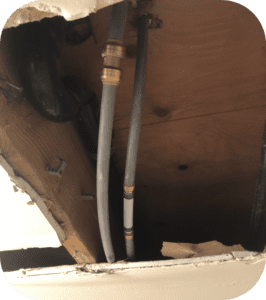Has your broker asked if you have Polybutylene (Poly-B) plumbing?
If your insurance company has asked you if you have poly-B plumbing in your building—or the building you want to purchase—you likely answered, “I don’t know.” Often, first-time homeowners and commercial building owners consider what type of plumbing their building has when an insurer asks about it. Insurance companies need to know what types of plumbing are present in the buildings they are considering insuring because some plumbing pose a greater risk of failure than others. Let’s talk about what poly-B is and why insurance companies and building owners need to know about it.
When it comes to understanding the plumbing system in your home, it’s important to know the different types of materials used and their characteristics. Let’s take a closer look at three common plumbing materials and how to identify them:
Polybutylene (PB):
- Material: Polybutylene is a plastic resin that was used extensively in residential plumbing systems from the late 1970s to the mid-1990s.
- Appearance: PB pipes are usually grey and sometimes blue. They have a distinguishable appearance with a slightly shiny surface.
- Issues: Over time, polybutylene pipes have been associated with a higher risk of failure due to deterioration caused by exposure to chlorine and other chemicals in water.
PEX:
- Material: PVC is a rigid plastic material commonly used for drainage and vent lines in plumbing systems.
- Appearance: PVC pipes are white or cream-coloured and have a smooth surface.
- Advantages: PEX excels in flexibility, corrosion resistance, thermal performance, and longevity, making it a cost-effective and reliable choice for plumbing.
PVC (Polyvinyl Chloride):
- Material: PVC is a rigid plastic material commonly used for drainage and vent lines in plumbing systems.
- Appearance: PVC pipes are white or cream-coloured and have a smooth surface.
- Advantages: PVC is resistant to corrosion and is a durable material for drain-waste-vent (DWV) systems. It is also used for cold-water supply lines.
Copper:
- Material: Copper is a metal that has been widely used for plumbing for many years.
- Appearance: Copper pipes are typically metallic and can develop a distinctive patina over time.
- Advantages: Copper is durable, resistant to corrosion, and has a long lifespan. It is commonly used for both hot and cold water supply lines
How to tell them apart:
- Polybutylene: Grey or blue plastic with a slightly shiny surface.
- PEX: color-coding (red for hot, blue for cold), high flexibility, smooth texture, and typically carries imprinted markings on the tubing.
- PVC: White or cream-coloured plastic with a smooth surface.
- Copper: Metallic appearance, can develop a patina over time.
The problem with Poly-B plumbing
Polybutylene (Poly-B) plumbing is a plastic resin piping used for supply lines. It was used in many homes and commercial buildings in Canada, most commonly between 1978 and 1997, as an alternative to copper piping. It was discontinued and removed from the Canadian plumbing code in 2005 because the pipes have shown to be more susceptible to bursting and leaking as they age. This means that if your building has poly-B, there’s a heightened risk of water damage.
Factors such as high chlorine levels in the water supply, prolonged UV exposure, and prolonged exposure to high heat increase the deterioration of poly-b materials.
What it looks like
Poly-B is a flexible plastic pipe that’s often grey, but it can also be blue, white, and red. To determine if poly-B exists in your building, look where lines are exposed, such as under sinks, in the utility room, or in the ceiling of an unfinished basement. It most likely has copper or brass fittings. If you suspect your pipes are poly-B, look for stamping on the piping, including PB or CSA-B. Some manufacturers also stamped the piping to indicate that it shouldn’t be used on continuous circulating hot water lines.

Why insurance companies care
Insurance companies consider the type of plumbing in a home for several reasons:
- Risk of water damage: Different pipe materials have varying risks of failure and susceptibility to leaks. Insurance companies want to assess the likelihood of water damage claims.
- Claims history: Certain types of pipes, such as polybutylene, have a history of issues. Insurance companies may inquire about the plumbing material to understand the potential for future claims.
- Preventive measures: Knowing the type of plumbing helps insurance companies assess whether the homeowner has taken preventive measures. For example, a home with polybutylene pipes might be considered a higher risk, prompting the insurance company to adjust premiums accordingly.
Why insurance companies need to know if you have Poly-B
If poly-B is in the building that you’re applying to insure, the insurance company may:
- Need to add a surcharge to the premium to reflect the higher risk of failure that poly-B poses.
- Give you a deadline to have the poly-B replaced.
- Deny offering water damage coverage.
- Deny offering any property coverage.
If you’re unsure whether your plumbing is poly-B, it’s best to have a plumber inspect the building’s plumbing.
Get support from a Westland advisor
Regardless of what type of plumbing your building has, we recommend working with your insurance broker to find insurance options that work best for you. Learn more about home insurance coverage and request a quote to get started.